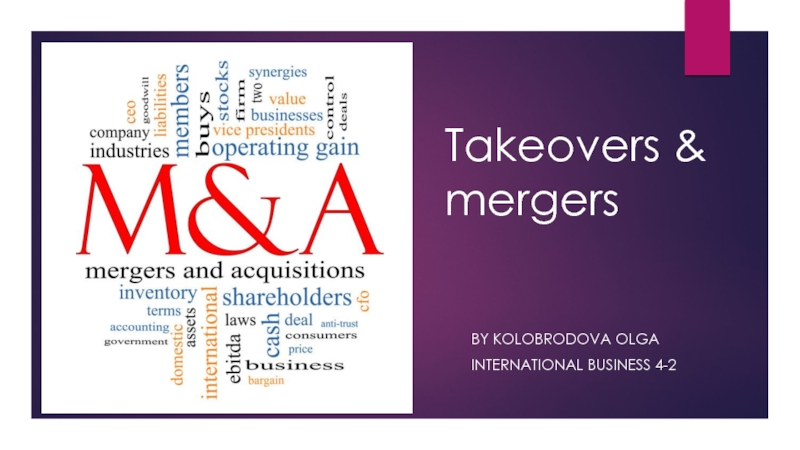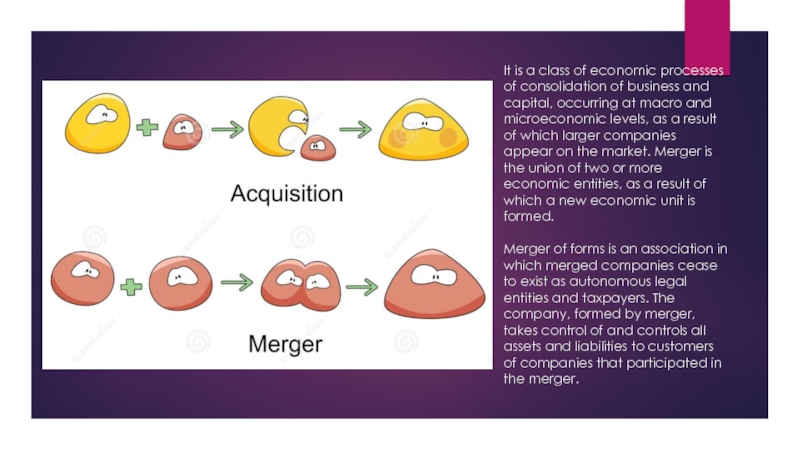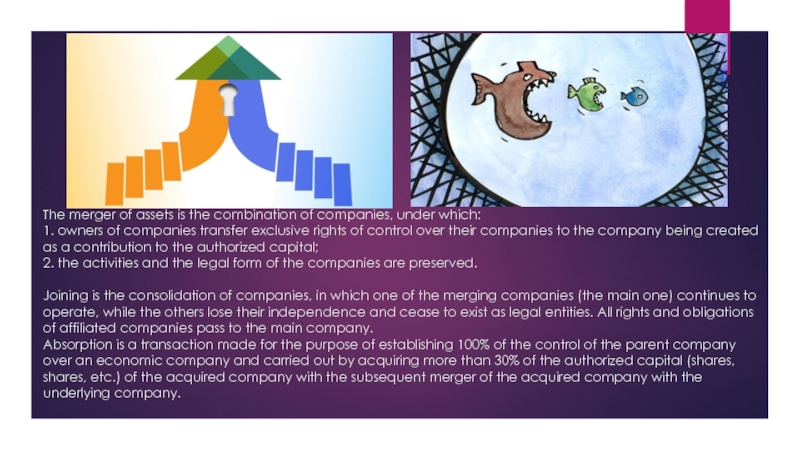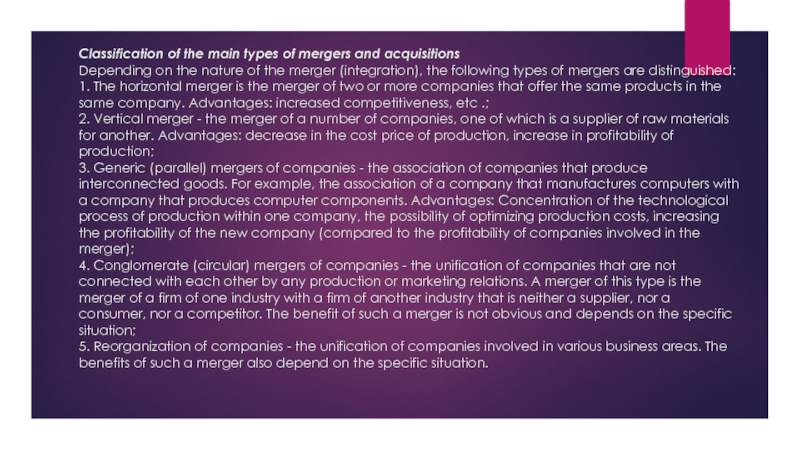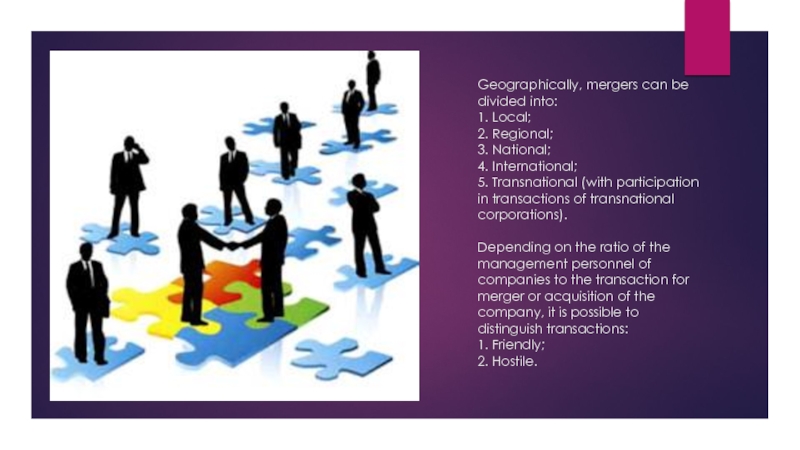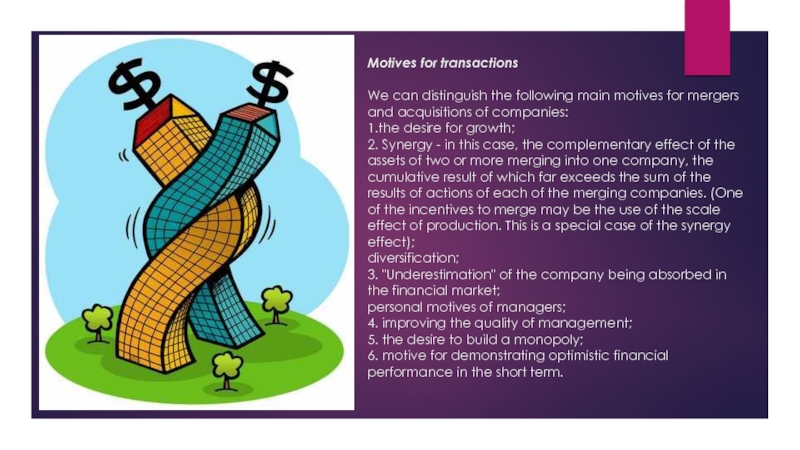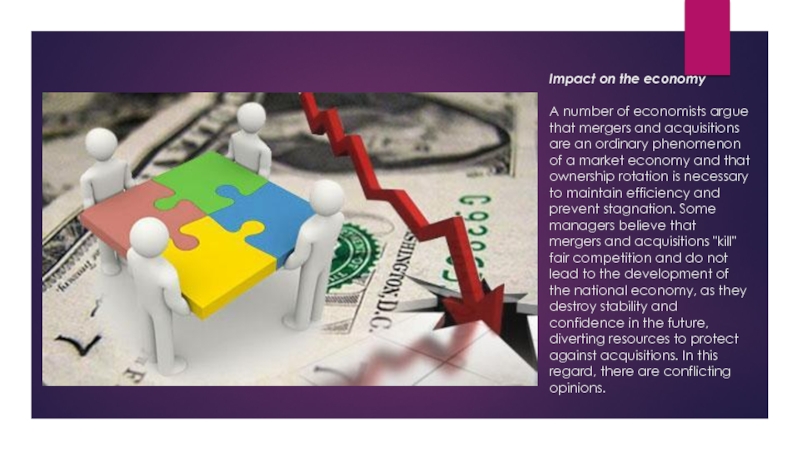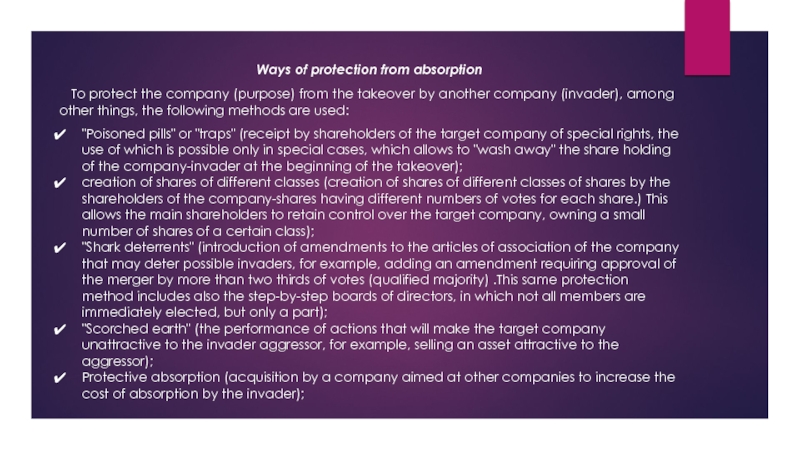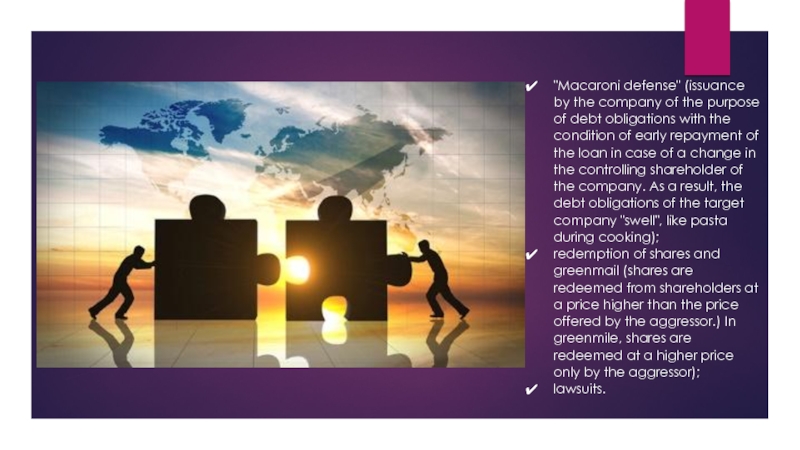- Главная
- Разное
- Дизайн
- Бизнес и предпринимательство
- Аналитика
- Образование
- Развлечения
- Красота и здоровье
- Финансы
- Государство
- Путешествия
- Спорт
- Недвижимость
- Армия
- Графика
- Культурология
- Еда и кулинария
- Лингвистика
- Английский язык
- Астрономия
- Алгебра
- Биология
- География
- Детские презентации
- Информатика
- История
- Литература
- Маркетинг
- Математика
- Медицина
- Менеджмент
- Музыка
- МХК
- Немецкий язык
- ОБЖ
- Обществознание
- Окружающий мир
- Педагогика
- Русский язык
- Технология
- Физика
- Философия
- Химия
- Шаблоны, картинки для презентаций
- Экология
- Экономика
- Юриспруденция
Takeovers & mergers презентация
Содержание
- 1. Takeovers & mergers
- 2. It is a class of economic processes
- 3. The merger of assets is the combination
- 4. Classification of the main types of mergers
- 5. Geographically, mergers can be divided into: 1.
- 6. Motives for transactions We can distinguish
- 7. Impact on the economy A number
- 8. Ways of protection from absorption To protect
- 9. "Macaroni defense" (issuance by the company of
- 10. Thanks for your attention! :)
Слайд 2It is a class of economic processes of consolidation of business
and capital, occurring at macro and microeconomic levels, as a result of which larger companies appear on the market. Merger is the union of two or more economic entities, as a result of which a new economic unit is formed.
Merger of forms is an association in which merged companies cease to exist as autonomous legal entities and taxpayers. The company, formed by merger, takes control of and controls all assets and liabilities to customers of companies that participated in the merger.
Слайд 3The merger of assets is the combination of companies, under which: 1.
owners of companies transfer exclusive rights of control over their companies to the company being created as a contribution to the authorized capital;
2. the activities and the legal form of the companies are preserved.
Joining is the consolidation of companies, in which one of the merging companies (the main one) continues to operate, while the others lose their independence and cease to exist as legal entities. All rights and obligations of affiliated companies pass to the main company.
Absorption is a transaction made for the purpose of establishing 100% of the control of the parent company over an economic company and carried out by acquiring more than 30% of the authorized capital (shares, shares, etc.) of the acquired company with the subsequent merger of the acquired company with the underlying company.
Слайд 4Classification of the main types of mergers and acquisitions Depending on the
nature of the merger (integration), the following types of mergers are distinguished:
1. The horizontal merger is the merger of two or more companies that offer the same products in the same company. Advantages: increased competitiveness, etc .;
2. Vertical merger - the merger of a number of companies, one of which is a supplier of raw materials for another. Advantages: decrease in the cost price of production, increase in profitability of production;
3. Generic (parallel) mergers of companies - the association of companies that produce interconnected goods. For example, the association of a company that manufactures computers with a company that produces computer components. Advantages: Concentration of the technological process of production within one company, the possibility of optimizing production costs, increasing the profitability of the new company (compared to the profitability of companies involved in the merger);
4. Conglomerate (circular) mergers of companies - the unification of companies that are not connected with each other by any production or marketing relations. A merger of this type is the merger of a firm of one industry with a firm of another industry that is neither a supplier, nor a consumer, nor a competitor. The benefit of such a merger is not obvious and depends on the specific situation;
5. Reorganization of companies - the unification of companies involved in various business areas. The benefits of such a merger also depend on the specific situation.
Слайд 5Geographically, mergers can be divided into: 1. Local; 2. Regional; 3. National; 4. International; 5. Transnational
(with participation in transactions of transnational corporations).
Depending on the ratio of the management personnel of companies to the transaction for merger or acquisition of the company, it is possible to distinguish transactions:
1. Friendly;
2. Hostile.
Слайд 6Motives for transactions We can distinguish the following main motives for mergers
and acquisitions of companies:
1.the desire for growth;
2. Synergy - in this case, the complementary effect of the assets of two or more merging into one company, the cumulative result of which far exceeds the sum of the results of actions of each of the merging companies. (One of the incentives to merge may be the use of the scale effect of production. This is a special case of the synergy effect);
diversification;
3. "Underestimation" of the company being absorbed in the financial market;
personal motives of managers;
4. improving the quality of management;
5. the desire to build a monopoly;
6. motive for demonstrating optimistic financial performance in the short term.
Слайд 7Impact on the economy A number of economists argue that mergers and
acquisitions are an ordinary phenomenon of a market economy and that ownership rotation is necessary to maintain efficiency and prevent stagnation. Some managers believe that mergers and acquisitions "kill" fair competition and do not lead to the development of the national economy, as they destroy stability and confidence in the future, diverting resources to protect against acquisitions. In this regard, there are conflicting opinions.
Слайд 8Ways of protection from absorption
To protect the company (purpose) from the
takeover by another company (invader), among other things, the following methods are used:
"Poisoned pills" or "traps" (receipt by shareholders of the target company of special rights, the use of which is possible only in special cases, which allows to "wash away" the share holding of the company-invader at the beginning of the takeover);
creation of shares of different classes (creation of shares of different classes of shares by the shareholders of the company-shares having different numbers of votes for each share.) This allows the main shareholders to retain control over the target company, owning a small number of shares of a certain class);
"Shark deterrents" (introduction of amendments to the articles of association of the company that may deter possible invaders, for example, adding an amendment requiring approval of the merger by more than two thirds of votes (qualified majority) .This same protection method includes also the step-by-step boards of directors, in which not all members are immediately elected, but only a part);
"Scorched earth" (the performance of actions that will make the target company unattractive to the invader aggressor, for example, selling an asset attractive to the aggressor);
Protective absorption (acquisition by a company aimed at other companies to increase the cost of absorption by the invader);
"Poisoned pills" or "traps" (receipt by shareholders of the target company of special rights, the use of which is possible only in special cases, which allows to "wash away" the share holding of the company-invader at the beginning of the takeover);
creation of shares of different classes (creation of shares of different classes of shares by the shareholders of the company-shares having different numbers of votes for each share.) This allows the main shareholders to retain control over the target company, owning a small number of shares of a certain class);
"Shark deterrents" (introduction of amendments to the articles of association of the company that may deter possible invaders, for example, adding an amendment requiring approval of the merger by more than two thirds of votes (qualified majority) .This same protection method includes also the step-by-step boards of directors, in which not all members are immediately elected, but only a part);
"Scorched earth" (the performance of actions that will make the target company unattractive to the invader aggressor, for example, selling an asset attractive to the aggressor);
Protective absorption (acquisition by a company aimed at other companies to increase the cost of absorption by the invader);
Слайд 9"Macaroni defense" (issuance by the company of the purpose of debt
obligations with the condition of early repayment of the loan in case of a change in the controlling shareholder of the company. As a result, the debt obligations of the target company "swell", like pasta during cooking);
redemption of shares and greenmail (shares are redeemed from shareholders at a price higher than the price offered by the aggressor.) In greenmile, shares are redeemed at a higher price only by the aggressor);
lawsuits.
redemption of shares and greenmail (shares are redeemed from shareholders at a price higher than the price offered by the aggressor.) In greenmile, shares are redeemed at a higher price only by the aggressor);
lawsuits.
